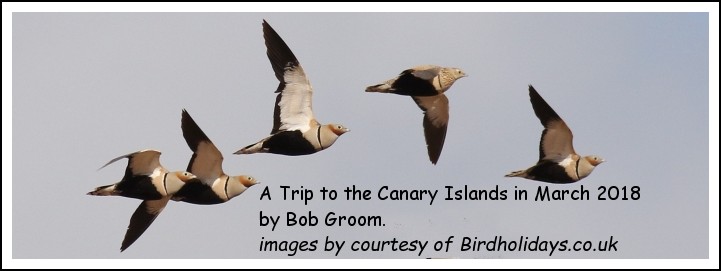
Trip to the Canary Islands (Fuerteventura and Tenerife) March 3rd - 10th with Bird Holidays Leaders Lance Degnan and Ian Smith.
My overseas birdwatching trip this year was rather different to previous tours, but no less rewarding. The Canary Islands species list is somewhat limited, if you exclude rare vagrants, and 65 to 70 is considered a really good total. We fell a little short of that target, however, but the accent is very much on quality rather than quantity. Although it had been unusually cool and wet just before our visit, fortunately we didn't encounter any rain on either island.
We flew to Fuerteventura for three nights at the Casa Viela, La Oliva in the north of the island, not far from the famous Tindaya Plain. Before visiting that well known site we paid several visits to a site known to the leaders that produced brilliant views of several Houbara Bustards,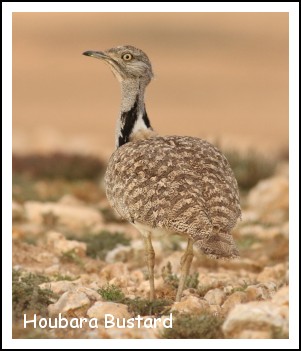 including a male displaying. (Previously I'd only had a ten second view of one on the island in the late 1990s!) Although distributed across much of North Africa and also found (but now separated as MacQueen's Bustard) in the Middle East (wintering) and Central Asia (breeding) it is rare and persecuted and therefore extremely secretive. Only in Fuerteventuara (and the other big Eastern island, Lanzarote), where it is protected, can good views be readily obtained. It tends to walk, rather than fly as vehicles don't alarm it. We saw several birds well, including a male displaying and we even saw a female on a nest (very lucky!). It was a magical experience to see such rare birds so well. including a male displaying. (Previously I'd only had a ten second view of one on the island in the late 1990s!) Although distributed across much of North Africa and also found (but now separated as MacQueen's Bustard) in the Middle East (wintering) and Central Asia (breeding) it is rare and persecuted and therefore extremely secretive. Only in Fuerteventuara (and the other big Eastern island, Lanzarote), where it is protected, can good views be readily obtained. It tends to walk, rather than fly as vehicles don't alarm it. We saw several birds well, including a male displaying and we even saw a female on a nest (very lucky!). It was a magical experience to see such rare birds so well.
In the same semi-desert areas we had close views of several beautiful Cream-Coloured Coursers. We were lucky enough to regularly see Barbary Partridges, which apparently had been in short supply on the previous year's trip. Berthelot's Pipits, a Canary Islands endemic, were plentiful, as were Lesser Short-Toed Larks and Trumpeter Finches. Yellow-Legged Gulls were ubiquitous. Ravens, a local race and, apart from a small colony of choughs on the island of La Palma the only corvid in the Canary islands, were regularly seen. Palm (Laughing) Doves have established themselves on the island, competing with the noisy Collared Doves. It was also good to see pure Rock Doves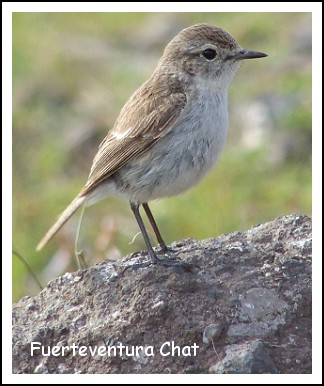 on the islands. Raptors were a bit in short supply but I did have good views of no less than 3 Barbary Falcons (close relative of the peregrine) and Kestrels and Buzzards were seen on both islands. Los Molinos, a large reservoir on Fuerteventura, held various waterbirds, including Spoonbills, Black-Winged Stilts, Little Egrets, Teal, and several wader species. A huge number of Ruddy Shelducks were present (barely even a breeding bird when I was last there), also Black-Bellied Sandgrouse and endemic Plain Swifts. In slightly less arid areas with scrubby trees and bushes there were many Hoopoes, Great Grey Shrikes (may soon be split as Desert form of Southern Grey Shrike), the attractive endemic Fuerteventura Chat (related to stonechats and whinchats), Spectacled and Sardinian Warblers. The pretty local race of African Blue Tit (blue replaced by black on the head, darker mantle) was common in Betancuria village and elsewhere. Stone Curlew was present in a field across from the hotel grounds. An odd sight was Cattle Egrets feeding on insects as they walked across tall euphorbia bushes in a garden next to the hotel grounds!
On the last afternoon before taking an internal flight west to Tenerife the following day, we trekked across a stony plain in the hot sun and very strong wind to the Barranco de la Torre (a narrow gorge with pools of water) where a vagrant African dwarf bittern had apparently been resident for some months. Needless to say, after a long wait we had to leave without seeing it but there were at least some waders there, including Greenshank, Green Sandpiper and more stilts. Nearby several Egyptian Vultures, both adults and juveniles, cruised around, their interest being in the local tip. Quite a few Monarch butterflies were seen on the island and Barbary Ground Squirrels provided entertainment during gaps in birding.
After the 40 minute inter-island flight on Tuesday afternoon our 2 minibuses headed up precipitous roads as on Tenerife our hotel (Villa Alba) was situated in the highest village on the island, on the islands. Raptors were a bit in short supply but I did have good views of no less than 3 Barbary Falcons (close relative of the peregrine) and Kestrels and Buzzards were seen on both islands. Los Molinos, a large reservoir on Fuerteventura, held various waterbirds, including Spoonbills, Black-Winged Stilts, Little Egrets, Teal, and several wader species. A huge number of Ruddy Shelducks were present (barely even a breeding bird when I was last there), also Black-Bellied Sandgrouse and endemic Plain Swifts. In slightly less arid areas with scrubby trees and bushes there were many Hoopoes, Great Grey Shrikes (may soon be split as Desert form of Southern Grey Shrike), the attractive endemic Fuerteventura Chat (related to stonechats and whinchats), Spectacled and Sardinian Warblers. The pretty local race of African Blue Tit (blue replaced by black on the head, darker mantle) was common in Betancuria village and elsewhere. Stone Curlew was present in a field across from the hotel grounds. An odd sight was Cattle Egrets feeding on insects as they walked across tall euphorbia bushes in a garden next to the hotel grounds!
On the last afternoon before taking an internal flight west to Tenerife the following day, we trekked across a stony plain in the hot sun and very strong wind to the Barranco de la Torre (a narrow gorge with pools of water) where a vagrant African dwarf bittern had apparently been resident for some months. Needless to say, after a long wait we had to leave without seeing it but there were at least some waders there, including Greenshank, Green Sandpiper and more stilts. Nearby several Egyptian Vultures, both adults and juveniles, cruised around, their interest being in the local tip. Quite a few Monarch butterflies were seen on the island and Barbary Ground Squirrels provided entertainment during gaps in birding.
After the 40 minute inter-island flight on Tuesday afternoon our 2 minibuses headed up precipitous roads as on Tenerife our hotel (Villa Alba) was situated in the highest village on the island,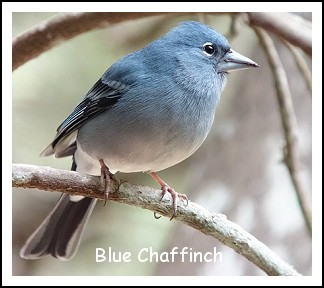 Vilaflor at 4,593 feet (1,400 metres). Cloud swirled round it as we arrived! The following morning we took the long road to and over the huge Caldera Las Canadas (30 miles in circumference) up above the clouds, with the magnificent spectacle of snow-capped Mount Teide high above us. At 12,199 feet (3,710 metres) Teide towers above the island and is higher than any peak in the Pyrenees and so ranks as the highest mountain on Spanish territory. It is a dormant volcano, but far from extinct, having last erupted (from a side vent) as recently as 1909. The picnic site of Las Lajas in the very extensive pinewoods is noted for the presence of Blue Chaffinches, a strikingly coloured endemic, slightly larger than the local race of Chaffinch which has a darker head and back and paler (peachy) underside than the British bird. Also present are many Canaries, relatives of the serin, the males brilliant yellow in the sunlight. There's a popular myth that the Islands are named after them. In fact the reverse is true, the birds are named after the Islands. The official version is that the islands were actually named after wild dogs (genus Canis) in Roman times. However a more recent theory is that the 'dogs' were actually monk seals (now extinct there), known to the native Guanche people as 'seadogs'.
The indigenous Canary Islands Chiffchaff was relatively common, its song quite different to the Common Chiffchaff, which winters in the islands. A little harder to find, the Canary Islands Goldcrest (sometimes known as the Tenerife Kinglet) eventually gave good views. Spanish Sparrows were numerous in certain areas (on both islands) but the Rock Sparrow seems to have declined on Tenerife and wasn't encountered. The local race of Great Spotted Woodpecker was seen Vilaflor at 4,593 feet (1,400 metres). Cloud swirled round it as we arrived! The following morning we took the long road to and over the huge Caldera Las Canadas (30 miles in circumference) up above the clouds, with the magnificent spectacle of snow-capped Mount Teide high above us. At 12,199 feet (3,710 metres) Teide towers above the island and is higher than any peak in the Pyrenees and so ranks as the highest mountain on Spanish territory. It is a dormant volcano, but far from extinct, having last erupted (from a side vent) as recently as 1909. The picnic site of Las Lajas in the very extensive pinewoods is noted for the presence of Blue Chaffinches, a strikingly coloured endemic, slightly larger than the local race of Chaffinch which has a darker head and back and paler (peachy) underside than the British bird. Also present are many Canaries, relatives of the serin, the males brilliant yellow in the sunlight. There's a popular myth that the Islands are named after them. In fact the reverse is true, the birds are named after the Islands. The official version is that the islands were actually named after wild dogs (genus Canis) in Roman times. However a more recent theory is that the 'dogs' were actually monk seals (now extinct there), known to the native Guanche people as 'seadogs'.
The indigenous Canary Islands Chiffchaff was relatively common, its song quite different to the Common Chiffchaff, which winters in the islands. A little harder to find, the Canary Islands Goldcrest (sometimes known as the Tenerife Kinglet) eventually gave good views. Spanish Sparrows were numerous in certain areas (on both islands) but the Rock Sparrow seems to have declined on Tenerife and wasn't encountered. The local race of Great Spotted Woodpecker was seen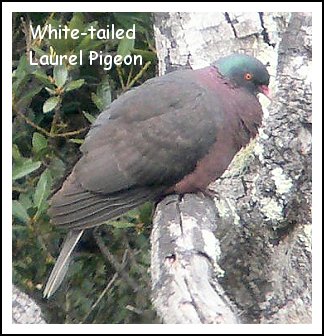 near the hotel and at Las Lajas.
A trip on the Car Ferry from Los Cristianos to the island of La Gomera was constantly accompanied by Cory's Shearwaters, an estimated 200 birds (many really close) seen on the crossing! We also saw 6 Short-finned Pilot Whales and a few Bottle-nosed Dolphins accompanied the ship. On the island our minibus ascended the steep roads to a viewpoint where the laurel forest on the mountainside could be scanned for White-Tailed Laurel Pigeons and Bolle's (Dark-Tailed) Pigeon, both endemics and new species for me. Later the sun disappeared and cloud closed in around us as we headed for a cafe before the return to Tenerife. Teide loomed ahead as we again scanned the sea for shearwaters but only Cory's obliged.
The last full day was spent revisiting Las Lajas (in a howling gale) and other high level sites but only Greenfinch was added to the list. However, we did get good views of the local race of Robin, now elevated to species status by some authorities as Erithacus Superbus. It differs from the European Robin in having a pronounced white eye-ring, a brighter red breast (ostensibly) and contrasting whiter underparts. (The robin has apparently been recently reclassified as an Old World flycatcher, despite its thrush/chat-like behaviour.) It was a relief next day to return to much milder temperatures in the UK as the group had flown out (from four different airports!) during a severe spell of cold weather. Despite a delayed take-off, strong tailwinds ensured an early arrival time. (Outward the pilot had told us that there was a 200 M.P.H. headwind!) It was a really good week and if you've not yet birded the Canary Islands, I highly recommend a visit.
Bob Groom near the hotel and at Las Lajas.
A trip on the Car Ferry from Los Cristianos to the island of La Gomera was constantly accompanied by Cory's Shearwaters, an estimated 200 birds (many really close) seen on the crossing! We also saw 6 Short-finned Pilot Whales and a few Bottle-nosed Dolphins accompanied the ship. On the island our minibus ascended the steep roads to a viewpoint where the laurel forest on the mountainside could be scanned for White-Tailed Laurel Pigeons and Bolle's (Dark-Tailed) Pigeon, both endemics and new species for me. Later the sun disappeared and cloud closed in around us as we headed for a cafe before the return to Tenerife. Teide loomed ahead as we again scanned the sea for shearwaters but only Cory's obliged.
The last full day was spent revisiting Las Lajas (in a howling gale) and other high level sites but only Greenfinch was added to the list. However, we did get good views of the local race of Robin, now elevated to species status by some authorities as Erithacus Superbus. It differs from the European Robin in having a pronounced white eye-ring, a brighter red breast (ostensibly) and contrasting whiter underparts. (The robin has apparently been recently reclassified as an Old World flycatcher, despite its thrush/chat-like behaviour.) It was a relief next day to return to much milder temperatures in the UK as the group had flown out (from four different airports!) during a severe spell of cold weather. Despite a delayed take-off, strong tailwinds ensured an early arrival time. (Outward the pilot had told us that there was a 200 M.P.H. headwind!) It was a really good week and if you've not yet birded the Canary Islands, I highly recommend a visit.
Bob Groom
|
|